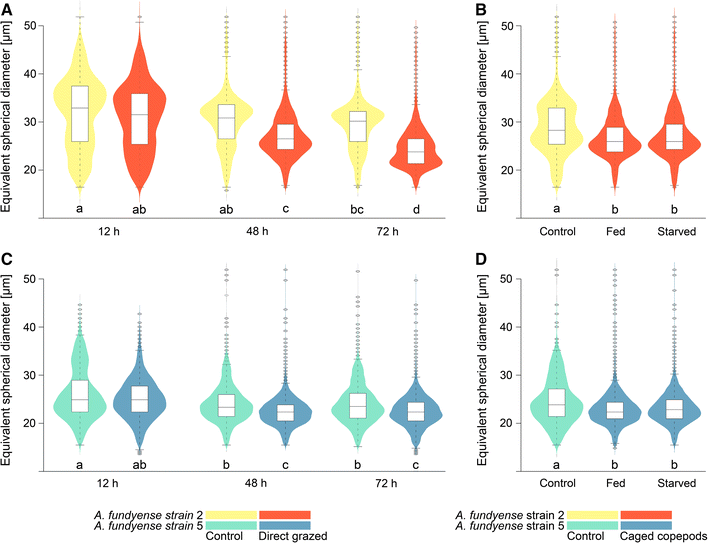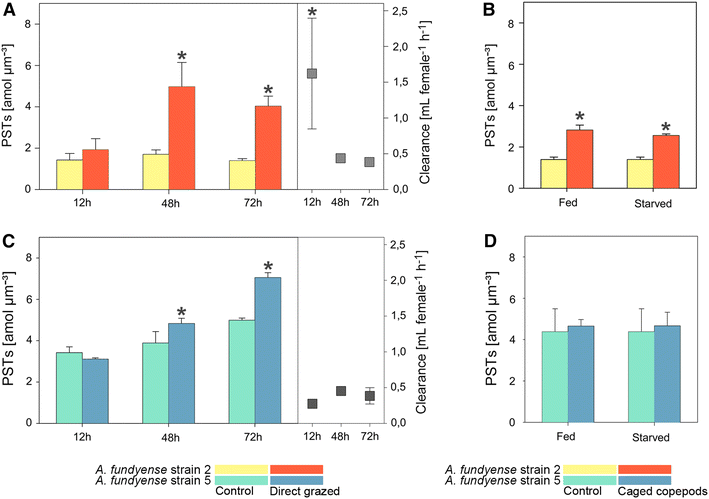Predator cues reduce intraspecific trait variability in a marine dinoflagellate
- PMID: 28241803
- PMCID: PMC5327569
- DOI: 10.1186/s12898-017-0119-y
Predator cues reduce intraspecific trait variability in a marine dinoflagellate
Abstract
Background: Phenotypic plasticity is commonplace and enables an organism to respond to variations in the environment. Plastic responses often modify a suite of traits and can be triggered by both abiotic and biotic changes. Here we analysed the plastic response towards a grazer of two genotypes of the marine dinoflagellate Alexandrium fundyense, evaluated the similarity of this response and discuss potential strain-specific trade-offs. We compared the expression of the known inducible defensive traits paralytic shellfish toxin content, and chain length. The effectiveness of the induced defense was assessed by monitoring grazing rates in both strains.
Results: Our results show that the grazer cues diminish phenotypic variability in a population by driving the phenotype towards a common defended morphotype. We further showed that the expression of the sxtA gene that initiates the paralytic shellfish toxin biosynthesis pathway does not correlate with an observed increase in the paralytic shellfish toxin analogue saxitoxin, and that toxin induction differs in its physiological characteristics in both strains.
Conclusion: Induced defense response in Alexandrium thus can directly affect further species interactions by reducing phenotypic variation and can result in genotype-dependent ecological trade-offs.
Keywords: Alexandrium; Grazer induced defense; Intraspecific trait variation; Predator–prey interaction; Saxitoxin gene expression.
Figures




Similar articles
-
Trait changes induced by species interactions in two phenotypically distinct strains of a marine dinoflagellate.ISME J. 2016 Nov;10(11):2658-2668. doi: 10.1038/ismej.2016.57. Epub 2016 Apr 19. ISME J. 2016. PMID: 27093044 Free PMC article.
-
A molecular and co-evolutionary context for grazer induced toxin production in Alexandrium tamarense.PLoS One. 2010 Nov 29;5(11):e15039. doi: 10.1371/journal.pone.0015039. PLoS One. 2010. PMID: 21124775 Free PMC article.
-
Relative importance of nitrogen sources, algal alarm cues and grazer exposure to toxin production of the marine dinoflagellate Alexandrium catenella.Harmful Algae. 2019 Apr;84:181-187. doi: 10.1016/j.hal.2019.04.006. Epub 2019 Apr 18. Harmful Algae. 2019. PMID: 31128802
-
Grazers modify the dinoflagellate relationship between toxin production and cell growth.Harmful Algae. 2023 Jul;126:102439. doi: 10.1016/j.hal.2023.102439. Epub 2023 Apr 29. Harmful Algae. 2023. PMID: 37290888 Review.
-
Marine food-borne dinoflagellate toxins.Int Rev Cytol. 1983;82:99-150. doi: 10.1016/s0074-7696(08)60824-4. Int Rev Cytol. 1983. PMID: 6352551 Review. No abstract available.
Cited by
-
High-resolution multiomics links nutrients and mixotrophy to toxicity in a harmful bloom of the haptophyte Chrysochromulina leadbeateri.Sci Adv. 2025 Jun 27;11(26):eadv3390. doi: 10.1126/sciadv.adv3390. Epub 2025 Jun 25. Sci Adv. 2025. PMID: 40561027 Free PMC article.
-
Ecophysiological Aspects and sxt Genes Expression Underlying Induced Chemical Defense in STX-Producing Raphidiopsis raciborskii (Cyanobacteria) against the Zooplankter Daphnia gessneri.Toxins (Basel). 2021 Jun 8;13(6):406. doi: 10.3390/toxins13060406. Toxins (Basel). 2021. PMID: 34200983 Free PMC article.
-
Predator-induced defence in a dinoflagellate generates benefits without direct costs.ISME J. 2021 Jul;15(7):2107-2116. doi: 10.1038/s41396-021-00908-y. Epub 2021 Feb 12. ISME J. 2021. PMID: 33580210 Free PMC article.
-
The Genetic Basis of Toxin Biosynthesis in Dinoflagellates.Microorganisms. 2019 Jul 29;7(8):222. doi: 10.3390/microorganisms7080222. Microorganisms. 2019. PMID: 31362398 Free PMC article. Review.
-
What Does It Mean to Be(Come) Arctic? Functional and Genetic Traits of Arctic- and Temperate-Adapted Diatoms.Glob Chang Biol. 2025 Mar;31(3):e70137. doi: 10.1111/gcb.70137. Glob Chang Biol. 2025. PMID: 40110945 Free PMC article.
References
-
- Litchman E, Klausmeier CA. Trait-based community ecology of phytoplankton. Annu Rev Ecol Evol Syst. 2008;39(1):615–639. doi: 10.1146/annurev.ecolsys.39.110707.173549. - DOI
-
- Hansen B, Bjornsen PK, Hansen PJ. The size ratio between planktonic predators and their prey. Limnol Oceanogr. 1994;39(2):395–403. doi: 10.4319/lo.1994.39.2.0395. - DOI
-
- Van Donk E, Ianora A, Vos M. Induced defences in marine and freshwater phytoplankton: a review. Hydrobiologia. 2011;668:3–19. doi: 10.1007/s10750-010-0395-4. - DOI
Publication types
MeSH terms
Substances
LinkOut - more resources
Full Text Sources
Other Literature Sources

